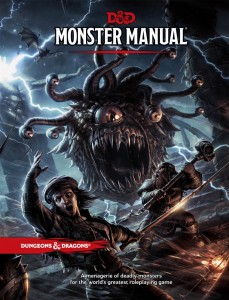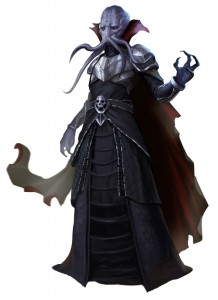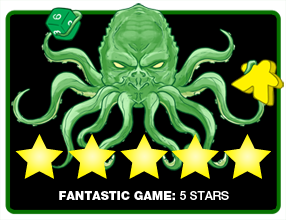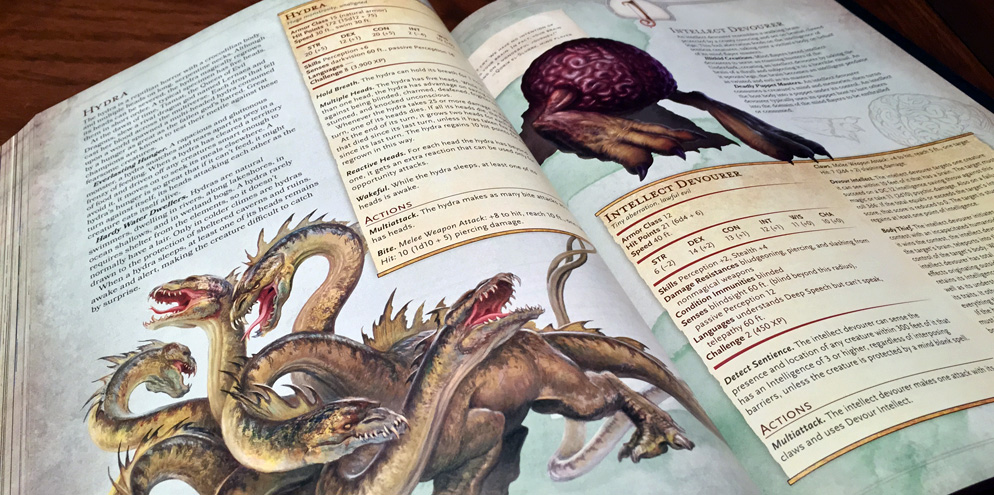 A little while ago we took our first venture into the 5th edition of Dungeons and Dragons with our look at the Player’s Handbook. The PHB is one of the most crucial books in the game’s arsenal and it left us filled with excitement at the new direction this classic RPG has taken.
A little while ago we took our first venture into the 5th edition of Dungeons and Dragons with our look at the Player’s Handbook. The PHB is one of the most crucial books in the game’s arsenal and it left us filled with excitement at the new direction this classic RPG has taken.
Today, we are going to climb further down the rabbit hole as we jump to the other side of the screen and take a look at the Monster Manual. A solid collection of creatures is critical for any on going RPG campaign. While crafting your hero is fun, every warrior needs someone, or something, to oppose him. So lets dive in and see if Wizards of the Coast (WotC) has continued this edition’s excellence with their new 5th edition Monster Manual.
On Design
I know monsters are really the crutch of the book, but I want to spend some time on the layout and design first. First off, the obvious. The artwork in this book is stellar, if not completely consistent. WotC obviously used a number of different artists for this book and some styles definitely appealed to me more than others. But overall I feel that all the monsters are well represented.
That’s what I’m most impressed with concerning the artwork, just about every monster has an illustration. I know in past editions, some monsters would get skipped over to save space, having only text. Now, every monster that needs an illustration has one. I say needs one because some monsters people don’t really need help visualizing. We’re talking dinosaurs, mundane animals and other fantasy tropes you’ve long since seen in movie or on TV. But as a DM, this is a great tool for new players to help immerse them into your story.
 Moving on from artwork, I also really liked the layout. The book just feels a lot more fluid than other editions. Most monsters have their own page, rather than just part of one. The stat blocks aren’t completely uniform, but seem to adjust to the size and location on the page that they need to be. To go along with that, the stat blocks are really easy to read/skim. Finding relevant information is simple and running a monster from these are a breeze. We’ll get into the nuts and bolts of stat blocks in a bit, but suffice to say, the layout of the blocks is one of the best so far.
Moving on from artwork, I also really liked the layout. The book just feels a lot more fluid than other editions. Most monsters have their own page, rather than just part of one. The stat blocks aren’t completely uniform, but seem to adjust to the size and location on the page that they need to be. To go along with that, the stat blocks are really easy to read/skim. Finding relevant information is simple and running a monster from these are a breeze. We’ll get into the nuts and bolts of stat blocks in a bit, but suffice to say, the layout of the blocks is one of the best so far.
Wizards of the Coast has wanted this edition to be a lot more thematic and immersive and they’ve stuck with that goal for the Monster Manual. There are nice touches all over the book, such as little “post-it note” like call-outs that have quotes about the monsters from adventures. It’s a nice little touch that adds some thematic flair.
To help you really build a world with these creatures, each monster’s entry begins with a lot of thematic text and story hooks that can explain the monster’s role in the world. They talk about where these monsters live, what they like, their motivations and other world building information. This is a nice change from previous editions where the text mostly just focused on combat encounters. I especially enjoyed the chapter on Beholders, be sure to give it a read when you get this book.
Three graphic designers are credited with working on the Monster Manual, and I really think that the trio of Bree Heiss, Emi Tanji and Barry Craig did an outstanding job with the overall layout. This Monster Manual is both a pleasure to flip through and very easy to use in your game (with one notable omission we’ll talk about later).
On New Rules
With a new edition comes new rules of course. Obviously a lot will feel familiar here as monsters work off of the same combat rules that the players do. But there are a few things here that are worth pointing out.
The first are Legendary Creatures. These seemed to have replaced “solo monsters” from 4th edition, which were a great idea, but never really worked out that well. Legendary Creatures are big bad monsters that have special powers and also can exert influence in the world around them.
 With legendary actions, a creature gets to take special actions outside of its turn. For example, the Aboleth gets to make an extra attack each turn or the demolich can cast energy drain. These are in addition to what they normally do on their initiative count.
With legendary actions, a creature gets to take special actions outside of its turn. For example, the Aboleth gets to make an extra attack each turn or the demolich can cast energy drain. These are in addition to what they normally do on their initiative count.
In addition to extra actions, many also have special traits. The aforementioned demilich has legendary resistance. 3 times a day if it fails a save, it can decide to succeed instead.
But where legendary monsters really get interesting is when a brave adventuring party decides to challenge the monster on its home turf. Each legendary monster has both lair actions and regional effects.
Regional effects are really interesting and make for some great story hooks. For example, our buddy the aboleth fouls all water within a mile of it’s lair. I can see that one easily working its way into a story hook when an adventuring party enters a new town.
But once you get down into a monsters lair, they can use it to really put the hurt on the players. For example, if you are fighting a Mummy Lord in its lair, it can cause pain on anyone trying to cast a spell of 4th level or lower. Or the Beholder can make the ground and walls of its lair do some crazy things. I won’t spoil the fun here, but taking on this monstrosity at home is going to be a challenge for sure.
On Challenges
Challenge ratings are still here, but they feel like they are more of a guide now than a hard and fast rule. Thanks to the 5th edition’s “bounded accuracy” mechanic, monsters are relevant longer than ever. It seems as if monsters now follow a sort of progression of: solo -> group -> minion. This means that the first time you encounter an ogre, you will probably just fight one of him. A few levels later, it will be a group of them. Finally, you will see hordes of them that you will wade through (minions). This allows monsters to be relevant to the party longer.
 Thanks to the bounded accuracy, the power creep has defiantly been scaled back for the monsters as well. For example, an Ogre has an Armor class of 11 and an attack of +6 (challenge rating 2). A storm Giant, armor class of 16 and a +14 to hit (challenge rating 13). Not as far apart as you’d expect with an 11 CR difference. Granted, the giant has about 200 more Hit Points than the ogre, but the scaled down numbers help to keep the variety of monsters around longer and encounters to not be such a battle of attrition.
Thanks to the bounded accuracy, the power creep has defiantly been scaled back for the monsters as well. For example, an Ogre has an Armor class of 11 and an attack of +6 (challenge rating 2). A storm Giant, armor class of 16 and a +14 to hit (challenge rating 13). Not as far apart as you’d expect with an 11 CR difference. Granted, the giant has about 200 more Hit Points than the ogre, but the scaled down numbers help to keep the variety of monsters around longer and encounters to not be such a battle of attrition.
Contrast that with the 3rd edition Storm Giant that has an Armor class of 27 and a +26 to attack (with the same CR 13). I much prefer this new editions bounded accuracy rules. All the numbers now are much more manageable and I don’t feel like I need a calculator to do a battle.
Finally, lets talk about save or die effects. They were fairly lethal in 3rd edition and previous. In 4th edition they got hit with the Nerf hammer pretty hard and were mostly a joke. In 5th edition, they’ve brought back the lethality, but not to the degree of the early editions. For example, the stone gaze of the Medusa will turn you to stone instantly if you fail your save by 5 or more. If you fail by less, you’ll have another save next round before you are petrified. That struck me as a nice balance between honoring the lethality of the monsters legacy and not being unfair to the players.
On Monsters
If the 5th Edition Player’s Handbook was the “greatest hits” of DnD rules, then this Monster Manual is the anthology of classic DnD monsters. Just about everything you want is in here. Dragons, death knights, the tarrasque, vampires, blights, and unicorns. You want it, you got it.
It’s a nice group of monsters that really has just about anything you might be looking for. I think back to the 4th edition of the monster manual didn’t include the metallic dragons for some odd reason. You had to wait for the monster manual 2 to get stats on all the dragons. Not anymore, there are a whopping 33 pages of dragons!
I even found some oddities I wasn’t expecting like the Flumph. I’m not sure I’ve ever actually seen one of those in a campaign, but he made his way into the book.
Honestly, I couldn’t find much fault with the monsters they chose to include here. There is a nice spread, although you will find more variety of lower level monsters than higher.
The one monster I was looking for that I didn’t find was the Girallon. This was a monster I pulled out a lot in 3rd edition when my players needed to learn some humility. It was a tad (ok, a lot) overpowered and I was curious to see what treatment it got in 5th edition. Unfortunately, the 4 armed gorilla didn’t make the cut. Boo!
On Extras
So lets wrap things up by first talking about the appendices. There are 2 in the book and the first one is all about miscellaneous creatures. Apes, dire wolves, boars, giant frogs and other less exciting creatures. They are there and will probably be mounts or fodder for your 1st level newbies. I should note that they don’t all have their own picture or thematic text, but really, do you need a story hook for a goat?
 Much, much, more exciting is the second appendix, non-player characters. These are a selection of 21 NPCs that a DM can quickly grab should the need arise. Need the stats for a priest your player bizarrely decided to attack (it happens, trust me), they got you covered. From guards to spies to assassins to cultists, there is a good amount of variety here. I only wish they would have beefed up this appendix even more, I could see using this a lot on the fly.
Much, much, more exciting is the second appendix, non-player characters. These are a selection of 21 NPCs that a DM can quickly grab should the need arise. Need the stats for a priest your player bizarrely decided to attack (it happens, trust me), they got you covered. From guards to spies to assassins to cultists, there is a good amount of variety here. I only wish they would have beefed up this appendix even more, I could see using this a lot on the fly.
Overall this has been a mostly glowing review and I haven’t pointed out too many flaws. Because there really aren’t very many. The one glaring omission I found was the lack of an index based on challenge rating. This index is extremely helpful tool for DMs trying to build encounters. You can take your level of PCs, look up that level in the CR index, and quickly find appropriate level monsters for them to combat. So I was fairly surprised to see it didn’t make the cut in this book. That was a big miss in my opinion. Fortunately, WotC has released a downloadable index as a PDF on their website. I just printed it out and threw it in the back of my book. Problem solved. Still, it would have been nice to have by default.
Final Thoughts
I loved the 5th edition Player’s Handbook and my love affair continues with the Monster Manual. This book is a gift to dungeons masters everywhere, especially those that like to build their own worlds and campaigns. Want to build a combat oriented campaign, well now you have a book that makes running combat encounters simple and flexible. Want a more thematic campaign, each monster has a big pile of flavor text to help you pull story hooks from.
If you are a dungeon master running the 5th edition of Dungeons and Dragons, then this book needs to be in your tool box. The Monster Manual an essential book for anyone running a campaign and WotC didn’t disappoint when they put this one together. You shouldn’t have any questions about picking this one up, it was made for you.
If you’d like to get a copy, the Dungeons and Dragons 5th Edition Monster Manual is available now for $31.
Final Score: 5 Stars – A well laid out and thematic book that will appeal to just about any DM out there. Other than a few minor points, there is nothing to complain about with this resource.
 Hits:
Hits:
• Fantastic layout
• Greatest hits of monsters
• Innovative new rules
• A photo for every monster!
Misses:
• No index by CR

























I’ve found the ink smudges if you run your finger over the words, even if you’re really careful. Still very expansive and nice!